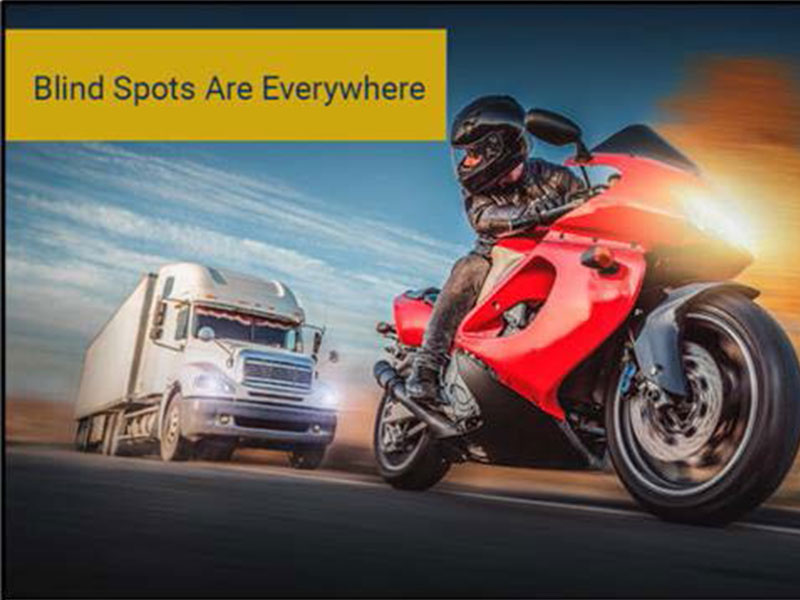A Motorcyclist’s Ability to See…and Be Seen Decreases Chance of Accidents
Introduction
According to many countries’ accident data, between half to three quarters of motorcycle accidents involve another vehicle. There are various names for these types of motorcycle-involved accidents, but invariably they result from either one or both parties not seeing the other in time to initiate collision avoidance maneuvers. The single-track motorcycle and its rider always present a slimmer profile than a larger 2-track, 4-wheeled automobile making it more easily blocked from an auto driver’s point of view (POV) by things like trees, poles, shrubs, other vehicles, and the automobile’s own blind spots created by pillars and side panels. To minimize these types of accidents auto drivers, need to “look for motorcyclists” while motorcycle riders must ride assuming they are not seen by drivers.
To See (motorcyclist’s POV)
The motorcycle rider should know he is more difficult to see and ride accordingly. This fact is taught in motorcycle training curriculums as well as being a written topic in state DMV Motorcycle Rider Handbooks. Still many riders who avoid professional training and ignore safety training messaging often do not understand how “invisible” they are to automobile drivers. In an age of distracted driving, auto drivers are even less likely to “look out for motorcyclists” while changing a radio station, switching lanes, entering an intersection or worse…reading an incoming text.
A trained and experienced motorcyclist will gain a trained eye which picks up small cues foretelling a motorist’s future action. As an example, a driver’s head movement to the left usually indicates the auto may follow the driver’s line of sight. A slight head movement to the right possibly indicates an imminent lane change to the right possibly without signaling. A more succinct “head check” to the right or left truly indicates the driver’s intention, but one cannot always be sure a driver will perform this necessary task before changing lanes into a motorcycle which was hiding in the car’s blind spot.
Driver’s blind spots can be anywhere. The front windshield pillar can block the view of a motorcycle in traffic or at a 4-way stop intersection. The right rear pillar of a car can block view of a motorcycle coming up on the auto’s right side. Another vehicle in the traffic mix can block the front view or a rear view of a motorcycle in traffic or while it is splitting lanes. Even a set of thick sunglass frames used by older drivers can create a blind spot to their side view. It now becomes a motorcycle rider’s responsibility to always “assume the auto driver does not see them.”
A rider should train himself or herself to “look for autos” about to move or change traffic positions. It almost becomes a predictive 6th sense used while riding. The rider must process all inputs for constantly changing traffic conditions and then process what is about to happen…next. Yes, the rider must predict the future movements of auto drivers to improve his or her collision avoidance abilities. Part of this gained 6th sense ability is also to always have an Exit Plan for what might happen next. Should the rider’s prediction of traffic movement not be accurate for some reason, what will he or she do next? Brake heavily in a straight line, counter steer away from the troubled area, or accelerate away from the troubled area? There may be several of these avoidance maneuvers which need to be executed in rapid succession to avoid a collision. These maneuvers are taught in both beginning and advanced motorcycle training classes available across the nation at community colleges or adult education centers.

This ability to predict automobile driver’s next moves is one which will save time, money, and lives. A motorcyclist needs to look for hidden clues including slick road surfaces, immoveable objects at the roadside, narrowing or disappearing traffic lanes, crowded stop lights, blocked views, driver head movements, directional blinkers and approaching intersections.
Did the rider see the car about to pass on the left? The motorcycle rider must have 360-degree awareness of what is happening ALL around him.

Motorcycle riders must assume they are invisible to motorists because they present a much slimmer vertical profile unlike large surface-area automobiles and trucks that compose 97% of the traffic mix.
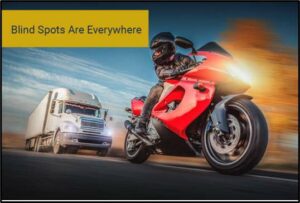
To Be Seen (motorist’s POV)
Each May, the Federal and State governments promote Motorcyclist Safety Awareness Month in hope of encouraging automobile drivers to “Look for Motorcyclists.” It is very easy for drivers to only see other automobiles, cars and trucks while excluding recognition of bicycles or motorcycles. Why? Because they are not consciously looking for smaller vehicles than their own—smaller vehicles do not present a threat especially when they are difficult to recognize against a crowded backdrop of busy streets and traffic. Even though motorcycles are smaller, can be more maneuverable and more fuel efficient, they still carry human life on board and should be equally recognized in the general traffic mix. This is the reason the Federal Motor Vehicle Safety Standards (FMVSS) now require motorcycles to be wired for daytime running lights (DRL Daytime Running Lights)—so motorists will better see them.
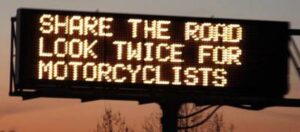
Many state governments promote “looking for motorcycles” to auto drivers during the month of May, Federally declared as Motorcycle Safety Awareness Month. It was found in the 1981 NHTSA-funded (National Highway Traffic Safety Administration) Motorcycle Accident Causation Study by USC’s Accident Research Center that the driver of the other vehicle violated the motorcycle right-of-way and caused the accident in two-thirds of those accidents. Dr. Harry Hurt who led the study concluded the failure of motorists to detect and recognize motorcycles in traffic is the predominating cause of motorcycle accidents. The driver of the other vehicle involved in a collision with the motorcycle did not see the motorcycle before the collision or did not see the motorcycle until too late to avoid the collision. One additional modern solution besides DRL Daytime Running Lights on motorcycles is the increased use of highly visible, brightly- colored helmets and apparel to be sure motorcyclists are seen by motorists.

Choosing to wear high-visibility motorcycle helmets and apparel greatly improves chances that motorists will see you before they pull out or turn in front of you. It has already been noted how high-visibility helmets and apparel further improve a rider’s chance of being seen by auto drivers beyond DRL Daytime Running Lights being on. It is even a habit of some riders to use their high beam headlight during the daytime to further increase their visibility if it does not bother the drivers in front looking in their rearview mirrors. The other aspect of “being seen” by motorists is to ride in a lane position so other drivers will see you. An example would be avoiding the blind spot of a car—the spot between where the internal rearview and external rearview mirrors cover.
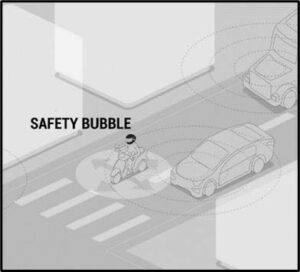
Riders should assume a car driver will not perform a “head check” looking into their blind spot before turning or changing lanes. Ride in a lane position where a driver can see you—and you can see them in their windows or rearview mirrors. If you cannot see the driver in any of their mirrors, then you know they cannot see you. When approaching a crowded intersection, flick on your high-beam headlight and auxiliary driving lights—it will help alert everyone you are coming through. Other traffic positioning strategies would be to fully realize the cars around you are blocking the views of cars ahead, to the side or behind you. It’s easy for a motorcycle to literally “disappear” between other cars because they are small by comparison to an automobile. Motorcyclists should ride with a “space bubble” around them (right) which grows larger as the traffic speed increases. The larger the “space” (left-right-forward-backward) the more time a rider has to react or avoid a collision should something unexpected occur.
The distance from an auto in front should be 2 seconds at lower speeds and increase to 3 seconds at higher speeds.
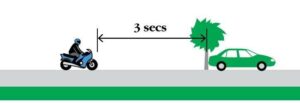
It is impossible for the driver of the red car (right) to see the approaching motorcycle behind the minivan. The rider should anticipate this situation approaching the intersection as potentially dangerous knowing in advance that he cannot be seen as easily as a full-sized automobile.

Conclusion
It is always too late when one hears an auto driver state “Sorry, I didn’t see you.” The damage has been done. Yes, it may have been the motorist’s fault, but that is not important particularly if the motorcycle rider has severe injuries because of the driver’s indiscretion. Drivers need to be more observant and careful when it comes to “seeing” motorcycles in the traffic mix. Likewise, riders also need to adopt an experienced level of traffic predictability while riding more aware, more conspicuously and “seeing” potential dangers before they become a problem. Be sure to exhibit these behaviors while riding:
- Proper road and lane positioning–to allow more drivers to see them.
- Avoiding motorists’ blind spots.
- Wear bright colors of helmet and protective gear—to force drivers to see them.
- Headlights on in daytime—high-beam is an option when safe.
- Auxiliary lights—add additional driving lights to appear larger to drivers.
- Predict dangerous situations before they occur.
- Practice collision avoidance maneuvers in a class or open parking lot.
We can decrease the accident statistics between motorcycles and automobiles, but we all—2 wheels or 4–must consciously focus on accident prevention and collision avoidance. How? See better. Be seen better.
By Eric Anderson
- Former Motorcycle Safety Foundation Instructor, publisher Safe Cycling magazine
- Former manufacturer of DOT/ECE approved motorcycle helmets & protective riding gear
- Dealernews (.com) columnist 35 years “Confessions of a Customer”
- Expert Witness in off-road and on-road motorcycles at www.motorcycleforensicsexpert.com
Appendix
- Conspicuity—Articles by Kevin Williams https://smarter-usa.org/wp-content/uploads/2021/05/Conspicuity-Articles-by-Kevin-Williams.docx.pdf
- Riders Attitudes toward Hi-Viz Clothing is changing–https://smarter-usa.org/wp-content/uploads/2019/06/NHTSA-Motorcyclists-Attitudes-on-High-Viz-2019.pdf
- California DMV Motorcycle Handbook–https://www.dmv.ca.gov/portal/file/motorcycle-driver-handbook-pdf/
- Dr. Harry Hurt’s Motorcycle Accident Causation Study of Factors and Identification of Countermeasures 1981 — https://www.webbikeworld.com/the-hurt-study/
- May is Motorcycle Safety Awareness Month – https://www.trafficsafetymarketing.gov/get-materials/motorcycle-safety/motorcycle-safety-awareness-month
- US DOT Traffic Tech Motorcyclists’ Attitudes About Using High-Visibility Gear to Improve Conspicuity: Findings from a Focus Group Study: dot_53595_DS1 Conspicious Hi Viz Apparel.pdf
About the Author: Eric Anderson, has spent his entire career developing and promoting motorcycles, ATV, UTV and off-road safety. He has spent over 40 years promoting responsible riding and driving behaviors in the powersports industry. Mr. Anderson has been a Motorcycle Safety Foundation (MSF) employee, publisher of Safe Cycling magazine, Rider Coach as well as, more recently, a certified Recreational Off-Highway Vehicle Association (ROHVA) Driver Coach. Since the 1980s, Mr. Anderson has worked in the industry specializing in protective apparel while simultaneously being elected to the MIC’s Board of Directors for 20 years. He has worked at the highest levels of the motorcycle and powersports industries with respect to issues pertaining to safe motorcycling. He has also worked on all aspects of motorcycle helmet construction, head protection innovations, manufacturing, compliance, and certification. Mr. Anderson also founded his own motorcycle helmet and protective apparel company known as Scorpion Sports with its extensive line of ScorpionExo brand of products. Areas of expertise include best practices for street use of motorcycles, motorcycle racing, motocross racing, trail riding, adventure motorcycling and enduro riding. Anderson also is an expert in the areas of 4-wheel driving in off-road conditions using UTVs, Jeeps, rock crawlers and specialty machines. He can be contacted at eric@motorcycleforensicsexpert.com or by phone at 949-874-2645.

